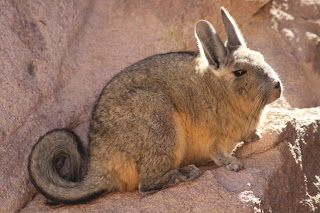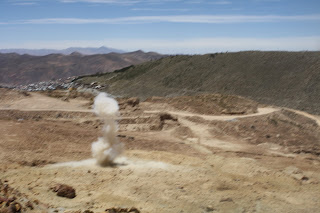We went on a tour of a working silver-lead-zinc mine in a mountain with an appalling history, in the world's highest city, Potosi (4060 metres). The thousands of miners working here today still do so in extremely dangerous conditions.
Lady Dynamite. The tour started with a visit to her shop in the miner's market. Here we each bought a stash of nitrogylcerine, detonators, coca leaves and soft drinks. These were presents for the mine workers we were to visit.
Efrain Mamami, our superb guide, explaining that the miners in the mountain chew coca leaves non-stop during their 12 or 13 hour working days. They don't eat at all during that time. They would be throwing up because of all the gases and dust in the tunnels and shafts.
Efra worked as a miner in the mountain, Cerro Rico, until 11 years ago. He then started taking tourists around the mines. He and three other ex-miners have just set up a new mine tour company which they say is the only one in Potosi which is owned and operated by miners. The company is called The Real Deal.
They get my *****star recommendation. Efra was an extremely informative and entertaining guide, with really good English.
MJC and Sarah from Cork, with Cerro Rico in the background. An ugly-looking mountain with an even uglier history. From the mid 1500s to mid 1700s, the Spanish colonisers established the world's most productive silver mine in the mountain. During that time, an estimated 9 million people died working in their mines here. The victims were indigenous people from Ecuador to Bolivia who were there under a forced labour system, and African slaves.
Of course, the Spanish Empire and Catholic Church in Spain and South America did very well out of it. During the 1600s, Potosi was one of the richest cities in the world.
The mountain has been long plundered of its incredible seams of silver but, as we were about to see, cooperatives of mining families are still making something of a dangerous living from the impoverished ore-bearing veins. We are not talking about high standards of health and safety here. Rock bottom in fact.
One tonne of rock being pulled and pushed by four miners in one of the tunnels. They have got about a quarter of a mile to go before reaching the outside. There are about 10 000 miners working in Cerro Rico today. They earn between US$200-250 per month. That is not a bad wage by the standards of most Bolivians, but the penalty is a life expectancy of about 40 years. Although we didn't see anyone younger than about 17 years old during our tour, there are some miners as young as 13 years, according to Efra.
MJC demonstrates the only available protective device against the thick clouds of fine rock dust in the tunnels. Long term exposure to dust and gases within the mines is the primary reason for the shortened lives of the workers. There are about 20 deaths per year through accidents, according to Efra. I was surprised it was not much higher. A terrible place to spend most of your waking life from the age of 16 (or younger).
Definitely not a place for claustrophobes. We had to crawl through holes and shafts on our hands and knees in some places and most of the time we were walking stooped or bent over.
We sat in a 3 foot high tunnel and watched some poor sod doing the 4 hour job of excavating a hole for an explosive charge.
At least we could get out after 5 minutes, albeit up a dodgy 15 ft ladder. Our colleague Rebecca's expression sums up how enjoyable that climb was.
El Tio. The Devil or chief God of the Earth for the miners. He is their protector as long as they give him regular offerings of coca leaves, fags and libations of the local 90% proof sugar cane liquor (tastes horrific). Once a year he also gets sacrificial llama blood.
To unwind after the stresses of our 2 hour subterranean tour, Efra made up some explosives. He lit the fuses and told us we had two minutes to pose for photographs.























































